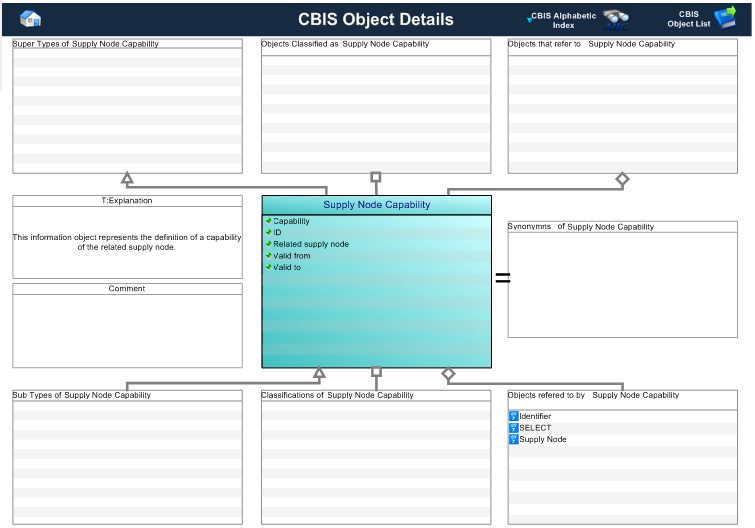Template:— supply_node_capability (sup_node_cap)
Context:— UK_Defence |
Date: 2009/04/17 11:50:21
Revision: 1.3
|
This section specifies the template supply_node_capability.
NOTE
The template has been defined in the context of
UK_Defence.
Refer to the business context for details of related templates.
NOTE
An explanation of a template and the associated instantiation path is
provided in the
Template overview
section.
This template describes how to represent the definition of a capability of the related supply node.
The supply node capability business object is used by those UK_Defence Data Exchange
Specifications that require information that defines a capability of the related supply node.
Figure 1 — Graphical Representation for Business Object Supply Node Capability
Supply Node Capability:
The definition of an Supply Node Capability object is:
Data about the definition of a capability of the related supply node.
|
Attribute name
|
Attribute description
|
Attribute type
|
Optionality
|
| Capability |
This is the capability that is defined for the related supply node. |
Relationship to Function or Task |
Mandatory |
| ID |
This is the Identifier of the supply node capability. |
Identifier |
Mandatory |
| Related Supply Node |
This is the reference to the supply node for which the capability is defined. |
Relationship to Supply Node |
Mandatory |
| Valid from |
This is the date from which the supply node capability was valid. |
Intrinsic |
Optional |
| Valid to |
This is the date to which the supply node capability was valid. |
Intrinsic |
Optional |
Table 1 — Supply Node Capability attribute details
The EXPRESS-G diagram in
Figure
2
shows the templates and EXPRESS entities that are required
to represent the template
"supply_node_capability".
The text highlighted in blue shows the template parameters.
Figure 2 — An EXPRESS-G representation of the Information model for supply_node_capability
The graphic for the template to be used in other EXPRESS-G diagrams
is shown in Figure
3
below.
Figure 3 — The graphical representation of the supply_node_capability template
The following input parameters are defined for this template:
This is the capability that is defined for the related supply node.
This is the identifier of the supply node capability.
The organization that created the associated identifier. Additionally
a Person or Information System could be defined when either of these are the source; see Identifier template.
This is the reference to the supply node for which the capability is defined.
This is the date from which the supply node capability was valid.
This is the date to which the supply node capability was valid.
The following reference parameters are defined for this template:
%^target = $supply_node_capability.sup_node_cap%
The following parameter combinations specify a uniqueness constraint:
Unique constraint: Supply_node_capability
The instantiation path shown below specifies the entities that are to be
instantiated by the template.
A description of templates and the syntax for the instantiation path is
provided in the
Templates Help/Information section.
The following entities are instantiated with attributes as specified:
The instance diagram in Figure
4
shows an example of the EXPRESS entities and templates that are instantiated by the template:
/supply_node_capability(capability='@30', ID='SNC123', source_organization='UK_Defence', related_supply_node='@73', valid_from='@78', valid_to='@83')/
(an illustration of the consolidated supply_node_capability template is shown in
Figure
5 below.)
Figure 4 — Entities instantiated by supply_node_capability template
The instance diagram in
Figure
5
shows the graphic symbol for the template that is to be
used in other instance diagrams. The example template is:
/supply_node_capability(capability='@30', ID='SNC123', source_organization='UK_Defence', related_supply_node='@73', valid_from='@78', valid_to='@83')/
Figure 5 — Instantiation of supply_node_capability template
Characterizations
No common characterizations of the template
supply_node_capability
have been identified. However, the ISO 10303-239 EXPRESS model
may enable other assignments to the entities instantiated by the template.




